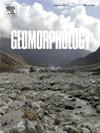黄河下游河漫滩全新世古洪水地层研究
IF 3.1
2区 地球科学
Q2 GEOGRAPHY, PHYSICAL
引用次数: 0
摘要
在过去4000年的历史中,黄河下游经历了巨大的洪水、决堤和河道冲刷,导致华北平原上沉积了大量的古洪水沉积物。然而,对冲积平原古洪水地层学的全面研究仍然缺乏。本文从沉积学、地层学、年代学等方面对黄河下游河道废弃区具有代表性的古洪水剖面进行了全面系统的分析。研究结果表明,地下地层主要由12种岩性相和4种相组合组成。这些相组合被解释为代表低地、古土壤、河岸和河道环境。与多变的河岸和河道沉积相比,在相对稳定的时期发育的低地和古土壤相可以用来细化地层对比。结合地层证据和放射性测年结果,在研究区内一致确定了4个沉积单元:单元I与∼8.0 ka以前的早期地貌面有关,单元II代表全新世中期的稳定时期,单元III具有不同的河岸洪水沉积物和古土壤序列,表明∼4.0 ka以来的环境突变,单元IV广泛分布,表明近千年以来洪水和洪水间期的频繁循环。在此基础上,提出了古洪水沿河道废弃区具有明显的向上粗化序列的沉积模式,说明了洪水的多阶段沉积过程。特别是黄河下游较厚的均匀粉砂和粘土层表现出明显的滞水沉积特征,探索了将传统方法应用于洪泛平原和类似下游河流人口较多、风险较高地区的潜力。本文章由计算机程序翻译,如有差异,请以英文原文为准。
Holocene paleoflood stratigraphy in the lower Yellow River floodplain, China
The lower Yellow River has experienced enormous floods, levee breaches, and channel avulsions over the last 4000-year history, resulting in the deposition of extensive paleoflood sediments across the North China Plain. However, a comprehensive investigation of paleoflood stratigraphy in alluvial plains is still lacking. Here, representative paleoflood profiles along the abandoned channel areas in the lower Yellow River have been comprehensively and systematically analyzed in terms of sedimentology, stratigraphy, and chronology. Our findings reveal that the subsurface stratigraphy is mainly formed by twelve lithological facies and four facies associations. The facies associations are interpreted to represent lowland, paleosol, overbank and channel environments. Compared with the mutable overbank and channel deposits, lowland and paleosol facies that have been developed during relatively stable periods without flood aggradation can be utilized to refine stratigraphic correlations. By combining stratigraphic evidence and radiometric dating results, four sedimentary units are consistently identified in the study area: Unit I related to the early geomorphic surface before the ∼8.0 ka, Unit II represents stability period during the middle Holocene, Unit III with different sequences of overbank flood deposits and paleosols suggesting an abrupt environmental change since ∼4.0 ka, and Unit IV of widely distributed indicating the frequent cycles of flood and interflood since the last millennium. Furthermore, a sedimentary model of paleofloods with a distinct upward-coarsening sequence along the abandoned channel areas is proposed, illustrating the multi-stage deposition of the flooding process. In particular, the thick layer of uniform silt and clay in the lower Yellow River demonstrates distinct features of slack water deposits, which explores the potential of applying the traditional method to more populated and higher-risk areas on floodplains and similar lower rivers.
求助全文
通过发布文献求助,成功后即可免费获取论文全文。
去求助
来源期刊

Geomorphology
地学-地球科学综合
CiteScore
8.00
自引率
10.30%
发文量
309
审稿时长
3.4 months
期刊介绍:
Our journal''s scope includes geomorphic themes of: tectonics and regional structure; glacial processes and landforms; fluvial sequences, Quaternary environmental change and dating; fluvial processes and landforms; mass movement, slopes and periglacial processes; hillslopes and soil erosion; weathering, karst and soils; aeolian processes and landforms, coastal dunes and arid environments; coastal and marine processes, estuaries and lakes; modelling, theoretical and quantitative geomorphology; DEM, GIS and remote sensing methods and applications; hazards, applied and planetary geomorphology; and volcanics.
 求助内容:
求助内容: 应助结果提醒方式:
应助结果提醒方式:


